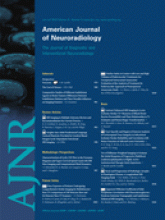Abstract
BACKGROUND AND PURPOSE: Gd-enhancement provides essential information in the assessment of brain tumors. However, enhancement does not always correlate with histology or disease activity, especially in the setting of current therapies. Our aim was to compare FDG-PET scans to ADC maps and Gd-enhanced MR images in patients with glial neoplasms to assess whether DWI might offer information not available on routine MR imaging sequences and whether such findings have prognostic significance.
MATERIALS AND METHODS: Institutional review board approval was obtained for this retrospective review, which was conducted in full compliance with HIPAA regulations. Twenty-one patients (11 men and 10 women) with glial tumors underwent FDG-PET and MR imaging, including ADC and Gd- enhancement. Subjectively, regions of interest were drawn around the following areas: 1) increased FDG uptake, 2) decreased signal intensity on ADC maps, and 3) Gd-enhancement. Objectively, FDG-PET and MR images were co-registered, and pixel-by-pixel comparison of ADC to PET values was made for all regions of interest. Correlation coefficients (r values) were calculated for each region of interest. Percentage overlap between regions of interest was calculated for each case.
RESULTS: Subjective evaluation showed 60% of patients with excellent or good correlation between ADC maps and FDG-PET. Pixel-by-pixel comparison demonstrated r values that ranged from −0.72 to −0.21. There was significantly greater overlap between decreased ADC and increased FDG-PET uptake (67.1 ± 15.5%) versus overlap between Gd-enhancement and increased FDG-PET uptake (54.4 ± 27.5%) (P < .05). ADC overlap was greater with increased FDG-PET than with Gd-enhancement in 8/9 cases. Survival data revealed that the presence of restricted diffusion on ADC correlated with patient survival (P < .0001).
CONCLUSIONS: ADC maps in patients with brain tumors provide unique information that is analogous to FDG-PET. There is a greater overlap between ADC and FDG-PET compared with Gd-enhancement. ADC maps can serve to approximate tumor grade and predict survival.
Abbreviations
- A
- area of restricted diffusion on an ADC map
- AA
- anaplastic astrocytoma
- ADC
- apparent diffusion coefficient
- AODG
- anaplastic oligodendroglioma
- d
- days
- F
- area of increased FDG-PET uptake
- DWI
- diffusion-weighted MR imaging
- FDG-PET
- fluorodeoxyglucose–positron-emission tomography
- FLAIR
- fluid-attenuated inversion recovery
- G
- area of gadolinium enhancement on MR imaging
- GBM
- glioblastoma multiforme
- Gd
- gadolinium
- Gd-DTPA
- gadolinium-diethylene-triamine pentaacetic acid
- IPAA
- Health Insurance Portability and Accountability Act
- LGA
- low-grade astrocytoma
- LGODG
- low-grade oligodendroglioma
- m
- months
- PET
- positron-emission tomography
- r value
- correlation coefficient
- ∩
- intersection
- Copyright © American Society of Neuroradiology












